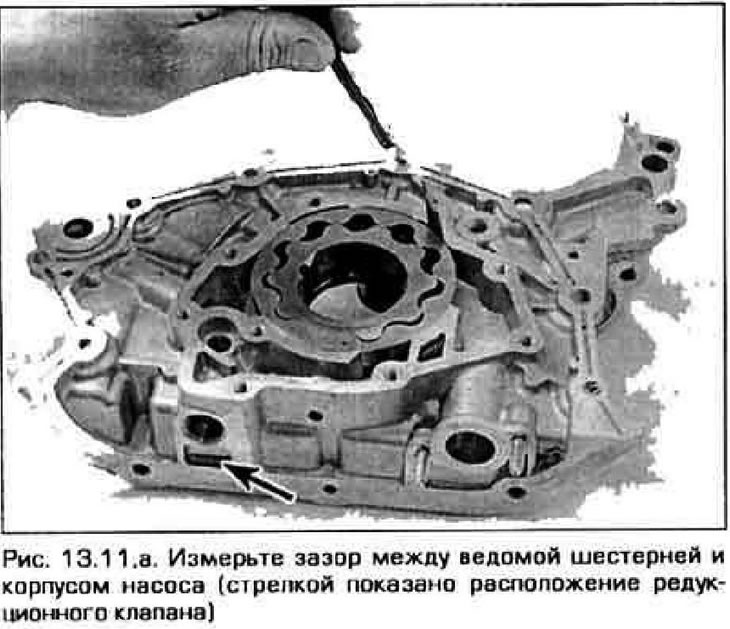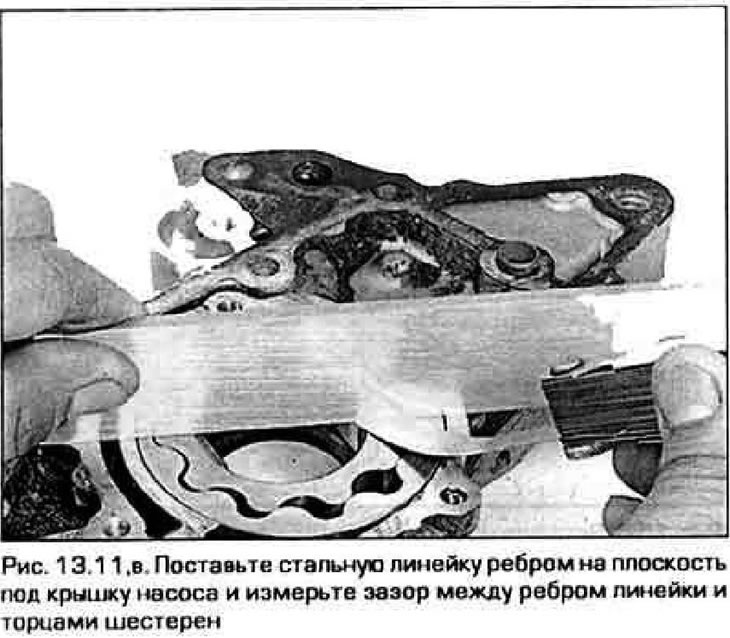Removing
1. Disconnect the negative cable from the battery.
Warning! If your car has an anti-theft audio system, make sure you have the unlock code before disconnecting the battery.
2. Remove the mudguard from under the engine. Remove accessory drive belts (see chapter 1).
3. Remove generator (see chapter 5) Remove the air conditioning compressor (without disconnecting hoses) and secure it somewhere to the side.
4. Remove the toothed belt and crankshaft sprocket (see paragraph 6).
5. Remove the oil pan (see paragraph 12). Remove the oil pickup pipe (pic. 13.5).

6. Release the bolts in the opposite order to that shown in fig. 13.23, unscrew them and remove the lower crankcase amplifier.
Note. On a 1998 model year engine, the bolt pattern on the side of the transmission is somewhat different.
7. Turn out bolts of fastening of the oil pump to the block of cylinders and remove the pump (fig 13.7). If necessary, gently pry the pump housing away from the block with a small screwdriver.

Examination
8. Place the pump on a workbench. Remember how deep the cuff is pressed into the pump housing. Pull the cuff out of the socket (do not damage the bore under the cuff).
9. Remove the screws connecting the cover to the pump housing. Remove and inspect the cover for damage and warping.
10. Turn out the reducing valve. Remember which side the valve parts are inserted into the bore. Remove the pump gears, wash them in solvent and reinstall.
11. Measure the following gaps with feeler gauges and compare them with the values given in Technical Data.
- A) Between driven gear and pump housing (pic. 13.11, a)
- b) Between the protrusions of the teeth of the driving and driven gears (pic. 13.11, b)
- V) Between the ends of the gears and the plane of the cover (pic. 13.11, in)



12. Measure the free length of the relief valve spring. Compare the result with the value specified in Technical data. If necessary, replace the spring.
13. Before assembly, clean and flush the pump parts.
14. Remove the outer surface of the new cuff with clean engine oil. Press the cuff into the socket with a hammer through a mandrel with an outer diameter slightly smaller than the outer diameter of the cuff (for this purpose, you can use a piece of pipe or an end head of a suitable size). Press the cuff to the same depth as it was before disassembly. Moisten with oil the working edge of the cuff, which is in contact with the toe of the crankshaft.
15. Dip pressure relief valve plunger in oil and assemble valve. Secure the valve plug with the circlip.
16. Dip the pump gears in oil and slide them into place.
17. Fill Coca Cavities with Vaseline (this will help the pump immediately start pumping oil after starting the engine).
18. Install the pump cover, coat the screw threads of the cover with an anti-tightening compound. Screw in and securely tighten the screws.
19. Inspect the oil pickup pipe and filter screen for clogged dirt. Flush the pipe and screen, or replace the entire assembly.
Installation
20. Scrape off the old gasket and sealant from the cylinder block mounting surface. Clean the mating surfaces of the pump and block with nitro thinner or acetone.
21. Apply a thin layer of sealant to the pump mounting surface, put a new gasket on it. Reinstall the pump. If necessary, rotate its gears to engage them with the toe of the shaft. Be careful: when applying sealant, make sure that it does not get into the pump channels.
22. Screw bolts and tighten them the demanded moment.
23. Wipe the bottom surface of the block of cylinders and an interfaced surface of the amplifier. Apply a bead of RTV sealant around the perimeter of the mounting surface of the booster and around the four bolt holes securing the booster to the rear mainframe cover. Install the booster within 5 minutes of applying the sealant. Gradually, in three or four passes, tighten the amplifier mounting bolts to the required value in the sequence shown in fig. 13.23.

24. The rest of the assembly is performed in the reverse order of disassembly.
